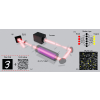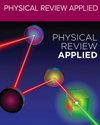利用热原子蒸汽的光学加速极端学习机
IF 4.4
2区 物理与天体物理
Q2 PHYSICS, APPLIED
引用次数: 0
摘要
机器学习正在成为一种广泛应用的技术,其增长速度令人印象深刻,这是因为它能为社会关注的各种问题提供实用的解决方案。应用和所需资源的增加开始受到当今硬件技术的限制。事实上,大型语言模型或高分辨率图像识别等新型机器学习课题都提出了所需计算时间长、能耗高的问题。在这种情况下,人们多年来一直在设计光学平台,目的是为机器学习开发更高效的硬件。在已探索的各种平台中,自由空间光学传播具有并行性、低能耗成本和计算速度等多种优势。在这里,我们提出了一种新的设计,它将在热原子蒸汽中传播的光束的强可调非线性特性与极端学习机模型相结合。我们通过数值和实验证明,在 MNIST 图像分类任务中使用这种自由空间非线性传播技术可以增强训练效果。我们指出了可以进一步优化的不同实验超参数,以提高平台的准确性。本文章由计算机程序翻译,如有差异,请以英文原文为准。

Optically accelerated extreme learning machine using hot atomic vapors
Machine learning is becoming a widely used technique with impressive growth due to the diversity of problems of societal interest for which it can offer practical solutions. This increase of applications and required resources start to become limited by present-day hardware technologies. Indeed, novel machine learning subjects such as large language models or high-resolution image recognition raise the question of large computing time and energy cost of the required computation. In this context, optical platforms have been designed for several years with the goal of developing more efficient hardware for machine learning. Among different explored platforms, optical free-space propagation offers various advantages: parallelism, low energy cost, and computational speed. Here, we present a new design combining the strong and tunable nonlinear properties of a light beam propagating through a hot atomic vapor with an extreme learning machine model. We numerically and experimentally demonstrate the enhancement of the training using such free-space nonlinear propagation on an MNIST image classification task. We point out different experimental hyperparameters that can be further optimized to improve the accuracy of the platform.
求助全文
通过发布文献求助,成功后即可免费获取论文全文。
去求助
来源期刊

Physical Review Applied
PHYSICS, APPLIED-
CiteScore
7.80
自引率
8.70%
发文量
760
审稿时长
2.5 months
期刊介绍:
Physical Review Applied (PRApplied) publishes high-quality papers that bridge the gap between engineering and physics, and between current and future technologies. PRApplied welcomes papers from both the engineering and physics communities, in academia and industry.
PRApplied focuses on topics including:
Biophysics, bioelectronics, and biomedical engineering,
Device physics,
Electronics,
Technology to harvest, store, and transmit energy, focusing on renewable energy technologies,
Geophysics and space science,
Industrial physics,
Magnetism and spintronics,
Metamaterials,
Microfluidics,
Nonlinear dynamics and pattern formation in natural or manufactured systems,
Nanoscience and nanotechnology,
Optics, optoelectronics, photonics, and photonic devices,
Quantum information processing, both algorithms and hardware,
Soft matter physics, including granular and complex fluids and active matter.
 求助内容:
求助内容: 应助结果提醒方式:
应助结果提醒方式:


